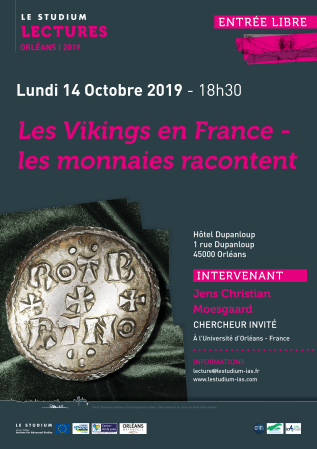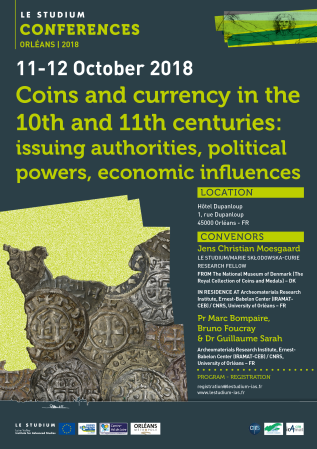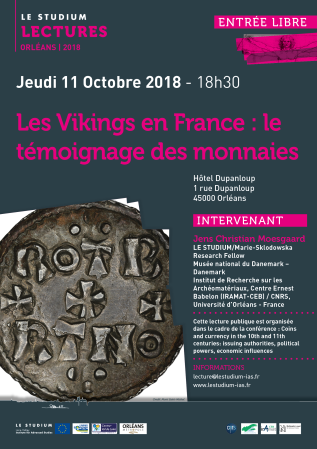Dr Jens-Christian Moesgaard

From
National Museum of Denmark (Royal Collection of Coins and Medals) - DK
In residence at
Host scientist
Dr Marc Bompaire
Project
Coins, Dies, Silver: For a new approach to the making of the Feudal period
Today’s society is marked by tensions between central power structures and centrifugal politic forces. Large population movements from one continent to another are also characteristic for our time. This is not new. Many moments of history have witnessed similar situations. Thus, in the 9th-10th c., the strong centralised Carolingian empire fell apart as victim of internal struggle and Viking raids from outside. How did it happen? Was the evolution from central power to local magnates a chaotic rupture or a smooth transition? How were the Vikings integrated into society? The answers to these questions may provide historic parallels to today’s society. However, our sources to knowledge are scarce. Written documents are rare and archaeology does not provide answers on these topics. But coins do. Coins were struck by the million and survive today by the thousand. Studying them, one gains insight into the level of organisation of the state, its institutions and its resources. The project “Coins, dies, silver: for a new approach to the making of the feudal period” looks at coinage in Normandy after the settlement of the Vikings. The methods of studying the dies used to strike the coins and the metallurgic composition of the coins will provide knowledge of the coin production. Normandy became one of the most powerful principalities of North-Western France. The Vikings adopted the Frankish monetary tradition, demonstrating how they integrated into Frankish society, or put in other words, evolved from Vikings into Normans. If one also looks at the neighbouring coinages in Ile-de-France and Centre-Val-de-Loire, one can grasp the how well-managed coinage was in within the emerging local principalities in all North-Western France. Looking at the weight, the fineness and the typology this project will show whether the coin production was continuous and well-planned and estimate the income to the lord from coinage. Put in a larger historical context these results will allow us to test the contradicting hypotheses of a chaotic, disorganised society or a regulated society, organised according to certain rules and able to integrate newcomers.
Publications
Un lot de 21 deniers ducaux normands du X e siècle a pu être étudié d après photographies, malheureusement de qualité inégale. 1 Il s agit de 20 exemplaires du type au nom de Saint-Ouen 2 et un exemplaire au nom de Louis IV d Outremer. 3 D après les renseignements disponibles, le lot serait, hélas, déjà dispersé. Il aurait été découvert dans un champ situé à une dizaine de kilomètres de Caen (Calvados) en direction de Courseulles-sur-Mer. Les communes d Amblie 4 et de Douvres-la- Délivrande (dans un jardin) ont été mentionnées, sans que cela a pu être confirmé. Il n a pas été possible d avoir davantage de précisions. Le monnayage au nom de Saint-Ouen est traditionnellement interprété comme ecclésiastique, mais il s agirait plutôt d une émission ducale ordinaire. La datation récemment proposée pour les deniers au nom de Saint-Ouen dans la deuxième moitié du règne de Guillaume Longue-Epée (927/933 42) se trouve confirmée par son association ici avec le denier rouennais du roi Louis IV (936 54).
Les résultats que nous présentons ici ont été obtenus dans le cadre d’un projet de recherche actuellement en cours, portant sur la monnaie ducale normande au Xe siècle. Ce projet a été rendu possible grâce à une bourse de recherche accordée par Le Studium, qui a pour mission de faire venir des chercheurs étrangers (in casu JCM) dans la Région Centre-Val de Loire pendant un an pour mener un projet de recherche en collaboration avec des chercheurs de la région (in casu Marc et GS de l’IRAMAT-CEB, CNRS/Université d’Orléans, UMR 5060). Prenant comme point de départ l’étude incontournable de Françoise Dumas portant sur les 8584 monnaies conservées du trésor de Fécamp, enfoui vers 980/9853 , notre projet aboutira à une monographie sur la monnaie normande du Xe siècle. Il nous a cependant semblé que l’aspect que nous présentons ici a une valeur exemplaire qui justifie sa publication en avant-première. Un de nos objectifs est l’étude de la composition élémentaire des pièces, spécialité de l’IRAMAT-CEB. Nous avons pour l’heure analysé 134 monnaies normandes par LA-ICP-MS (spectrométrie de masse couplée à un plasma inductif avec prélèvement par ablation laser), une méthode d’analyse quasi-non destructive qui permet de doser les constituants majeurs des alliages monétaires (dans ce cas l’argent et le cuivre) ainsi qu’un grand nombre d’éléments mineurs et traces.
Final reports
The transition in the 10th century from the centralised Carolingian state to the decentralised feudal principalities is a subject of debate among historians: was it a violent breakdown or a continuous evolution? The major problem facing historians is the scarcity of written sources. But coins are numerous and constitute a relevant source material. Indeed, Coinage is an official institution, and studying it informs us about the state of society and the organisation of the administration. The study of Norman coinage in the 10th century shows a large and well-managed production and a firm control of the circulation. Exchange fees provided income for the duke. This reflects a well-organised stable administration and an ability of controlling society, far from the chaotic, violent and anarchistic picture of early feudalism that is sometimes purported.




